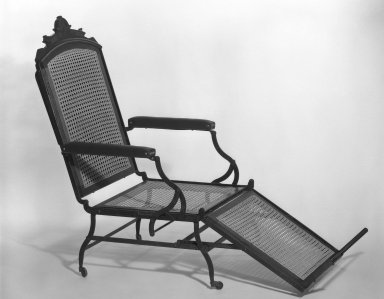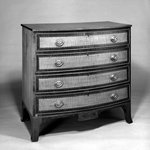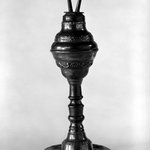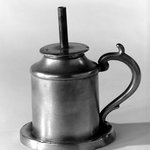Folding Invalid Chair
Decorative Arts and Design
This folding chair can assume more than fifty positions. The design for the chair is derived from European late eighteenth-century portable metal campaign furniture used by military officers in the field. The appeal of elaborate folding chairs to late nineteenth-century American consumers who lived in small urban spaces is confirmed by the nineteen United States patents granted between 1870 and 1889 for similar pieces of furniture. The designer of this chair, Cavedra B. Sheldon, sold his design to the Marks Adjustable Folding Chair Company, which manufactured it for almost twenty-five years. Furniture that metamorphosed into different forms for different uses was not only useful, but also signaled an avid interest in invention and innovation that marked American industry after the Civil War and ushered in the Machine Age.
The upholstery on this chair is modern but reproduces the elaborate schemes popular when the chair was made. Old trade cards such as the one suspended above and images from the Mmarks Company trade catalogue served as models. The detail of the fringe is copied exactly from a rare original fragment that survives on a similar chair in the Denver Art Museum.
MEDIUM
Iron, walnut, and new caning and upholstery
DATES
Patented 1876; Made ca. 1876–1895
DIMENSIONS
Open: 46 3/4 x 27 x 77 1/4 in. (118.7 x 68.6 x 196.2 cm)
Height Closed: 19 3/4 in. (50.2 cm)
(show scale)
MARKINGS
Stenciled in gold: on upper front seat rail, "PAT. FEB. 1-1876"; on lower front seat rail, "MARKS. A.F. CHAIR CO. LIMITED / 816 BROADWAY, NEW YORK".
SIGNATURE
no signature
INSCRIPTIONS
no inscriptions
ACCESSION NUMBER
81.34
CREDIT LINE
H. Randolph Lever Fund
CATALOGUE DESCRIPTION
Folding invalid chair, walnut, cane, and iron. Has iron frame, supported on casters painted black and decorated with gold and red lines, and gold, red, and green scrolls. Within the iron frame at the seat, back, and footrest panels are walnut frames with new caning. At the crest of the chair back is a shallow-carved stylized anthemion with incised line decoration. On either side of this are panels of walnut burl veneer and below is a curved, molded crest rail. The back of the chair has been upholstered in new fabric, the arms in new leather. The chair has a ratchet mechanism, which allows it to be folded up completely, opened as a chair, opened further as a lounge chair with foot rest (an iron brace falls to support the foot rest and an iron foot brace rises above the foot rest) and opened still further, when the back is let down to horizontal (also supported by an iron brace) to form a cot. Copy of patent attached to correspondence file.
Condition: Generally good. Caning and upholstery are modern. Cushions are lacking. Paint on iron frame is scraped and worn throughout but basically in good condition and stable. Some rust, especially at feet and ratchets, also where paint has flaked. Wear to wood at back of crest rail. Chip missing on back of proper right scroll on crest rail.
MUSEUM LOCATION
This item is not on view
CAPTION
Cavedra B. Sheldon. Folding Invalid Chair, Patented 1876; Made ca. 1876–1895. Iron, walnut, and new caning and upholstery, Open: 46 3/4 x 27 x 77 1/4 in. (118.7 x 68.6 x 196.2 cm). Brooklyn Museum, H. Randolph Lever Fund, 81.34. Creative Commons-BY (Photo: Brooklyn Museum, 81.34_overall_bw_IMLS.jpg)
IMAGE
overall, open chair, 81.34_overall_bw_IMLS.jpg. Brooklyn Museum photograph, 6/1983
"CUR" at the beginning of an image file name means that the image was created by a curatorial staff member. These study images may be digital point-and-shoot photographs, when we don\'t yet have high-quality studio photography, or they may be scans of older negatives, slides, or photographic prints, providing historical documentation of the object.
RIGHTS STATEMENT
Creative Commons-BY
You may download and use Brooklyn Museum images of this three-dimensional work in accordance with a
Creative Commons license. Fair use, as understood under the United States Copyright Act, may also apply.
Please include caption information from this page and credit the Brooklyn Museum. If you need a high resolution file, please fill out our online
application form (charges apply).
For further information about copyright, we recommend resources at the
United States Library of Congress,
Cornell University,
Copyright and Cultural Institutions: Guidelines for U.S. Libraries, Archives, and Museums, and
Copyright Watch.
For more information about the Museum's rights project, including how rights types are assigned, please see our
blog posts on copyright.
If you have any information regarding this work and rights to it, please contact
copyright@brooklynmuseum.org.
RECORD COMPLETENESS
Not every record you will find here is complete. More information is available for some works than for others, and some entries have been updated more recently. Records are frequently reviewed and revised, and
we welcome any additional information you might have.



























